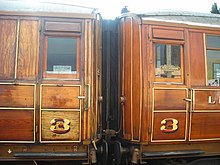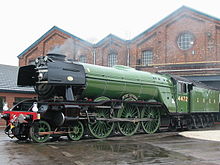London and North Eastern Railway
standard gauge | |
| Length | 6,590 miles (10,610 km) |
|---|---|
The London and North Eastern Railway (LNER) was the second largest (after
.History

The company was the second largest created by the Railways Act 1921. The principal constituents of the LNER were:
- Great Eastern Railway
- Great Central Railway
- Great Northern Railway
- Great North of Scotland Railway
- Hull and Barnsley Railway
- North British Railway
- North Eastern Railway
The total route mileage was 6,590 miles (10,610 km). The North Eastern Railway had the largest route mileage of 1,757 miles (2,828 km), whilst the Hull and Barnsley Railway was 106.5 miles (171.4 km).
It covered the area north and east of
The company also owned the most westerly track and stations in Great Britain, in the form of the West Highland Railway to Arisaig and Mallaig, previously owned by the North British Railway.
The LNER inherited four of London's termini:
The LNER owned:
- 7,700 locomotives, 20,000 coaching vehicles, 29,700 freight vehicles, 140 items of electric rolling stock, 6 electric locomotives and 10 rail motor cars
- 6 turbine and 36 other steamers, and river boats and lake steamers, etc.
In partnership with the London, Midland and Scottish Railway (LMS), the LNER was co-owner of the Midland and Great Northern Joint Railway, the UK's biggest joint railway, much of which competed with the LNER's own lines. The M&GNJR was incorporated into the LNER in 1936. In 1933, on the formation of the London Passenger Transport Board, the LNER acquired the remaining operations of the Metropolitan Railway Company.
The LNER was the majority partner in the Cheshire Lines Committee and the Forth Bridge Railway Company.
It depended on freight from heavy industry in Yorkshire, the north east of England and Scotland, and its revenue was reduced by the economic depression for much of the early part of its existence. In a bid to improve financial efficiency, staffing levels reduced from 207,500 in 1924 to 175,800 in 1937.[6] For investment to retain freight traffic, new marshalling yards were built in Whitemoor in Cambridgeshire, and Hull in Yorkshire to attempt to retain freight traffic.
Sir Ralph Wedgwood introduced a Traffic Apprenticeship Scheme to attract graduates, train young managers and provide supervision by assistant general manager Robert Bell for career planning. The company adopted a regional managerial system, with general managers based in London, York and Edinburgh, and for a short time, Aberdeen.[6]
For passenger services, Sir Nigel Gresley, the Chief Mechanical Engineer built new powerful locomotives and new coaches.[7] Later developments such as the streamlined Silver Jubilee train of 1935 were exploited by the LNER publicity department, and embedded the non-stop London to Edinburgh services such as the Flying Scotsman in the public imagination. The crowning glory of this time was the world record speed of 126 miles per hour (203 km/h) achieved on a test run by LNER Class A4 4468 Mallard.[8]
In 1929, the LNER chose the typeface
Continental shipping services were provided from Harwich Parkeston Quay.[16]
The company took up the offer in 1933 of government loans at low interest rates and electrified the lines from Manchester to Sheffield and Wath yard, and also commuter lines in the London suburban area.[17]
Ancillary activities
The LNER inherited:
- 8 canals, including the Ashton, Chesterfield, Macclesfield, Nottingham & Grantham and Peak Forest
- Docks and harbours in 20 locations, including Grimsby, Hartlepool, Hull, Immingham, Middlesbrough, some eastern Scottish ports, Harwich, Lowestoft and London
- Other wharves, staithes, piers
- 2 electric tramways
- 23 hotels (20 of them were nationalised in 1948 as British Transport Hotels. Of the other three,[18] Cruden Bay Hotel was requisitioned in 1940, Palace Hotel, Aberdeen caught fire in 1941 and the Yarborough Hotel, New Holland was sold, being advertised for sale in 1947.[19])
- A 49% stake in the haulage firm Mutter, Howey & Co. Ltd.[1]
It took shares in a large number of bus companies, including for a time a majority stake in United Automobile Services Ltd. In Halifax and Sheffield, it participated in Joint Omnibus Committees with the LMS and the Corporation.[1]
In 1935, with the LMS,
In 1938 it was reported that the LNER, with 800 mechanical horse tractors, was the world's largest owner of this vehicle type.[20]
Ships
The LNER operated a number of ships, including three rail ferries. In total, 6 turbine and 36 other steamers, and river boats and lake steamers were used by the company during its existence.
Liveries

The most common liveries were lined apple green on passenger locomotives (much lighter and brighter than the green used by the Great Western Railway) and unlined black on freight locomotives, both with gold lettering. Passenger carriages were generally varnished teak (wood) finish; the few metal-panelled coaches were painted to represent teak.
Some special trains and
Advertising
The LNER covered quite an extensive area of Britain, from London through East Anglia, the East Midlands and Yorkshire to the north east of England and Scotland. The 1923 grouping meant that former rivals within the LNER had to work together. The task of creating an instantly recognisable public image went to William M. Teasdale, the first advertising manager. Teasdale was influenced by the philosophies and policies of Frank Pick, who controlled the style and content of the London Underground's widely acclaimed poster advertising. Teasdale did not confine his artists within strict guidelines but allowed them a free hand. William Barribal designed a series of bold Art Deco posters in the 1920s and 1930s.[21] When Teasdale was promoted to Assistant General Manager, this philosophy was carried on by Cecil Dandridge who succeeded him and was the Advertising Manager until nationalisation in 1948. Dandridge was largely responsible for the adoption of the Gill Sans typeface, later adopted by British Railways.
The LNER was a very industrial company: hauling more than a third of Britain's coal, it derived two thirds of its income from freight. Despite this, the main image presented was one of glamour, of fast trains and sophisticated destinations. Advertising was highly sophisticated and advanced compared with those of its rivals. Teasdale and Dandridge commissioned top graphic designers and poster artists such as Tom Purvis to promote its services and encourage the public to visit the holiday destinations of the east coast in the summer.
Chief office holders
Chairmen of the Board
- William Whitelaw 1923 - 1938
- Sir Ronald Matthews 1938[22] - 1948
Chief General Managers
- Sir Ralph Wedgwood1923 - 1939
- Charles Henry Newton 1939[23] - 1947
- Miles Beevor 1947 - 1948 (acting)
Chief mechanical engineers


- Mallardholds the record to this day. Gresley died in office in 1941.
- Edward Thompson's short reign (1941–1946) was a controversial one. A reputed detractor of Gresley even before his elevation to the post of CME, there are those who interpret many of his actions as being motivated by dislike of his predecessor; this demonisation has been questioned by Simon A.C. Martin who argues that his actions were directed by the needs of WWII rather than dislike of Gresley or his practices.[citation needed] Thompson accepted that Gresley's designs had their flaws as well as their brilliance but still included them as part of his future locomotive stud. His record is best served by his solid and dependable freight and mixed-traffic locomotives built under and for wartime conditions. He retired in 1946.
- Pacific express passenger locomotives, most completed after nationalisation. Peppercorn was a student and admirer of Gresley and his locomotives combined the classic lines of Gresley's with the reliability and solidity they never quite achieved.
Nationalisation
The company was nationalised in 1948 along with the rest of the railway companies of Great Britain to form British Railways. It continued to exist as a legal entity for nearly two more years, being formally wound up on 23 December 1949.[24]
On the privatisation of British Rail in 1996, the franchise to run long distance express trains on the East Coast Main Line was won by
Following the collapse of Virgin Trains East Coast in May 2018, the newly-nationalised operator of the East Coast Main Line was named London North Eastern Railway to evoke the earlier company.[25]
Cultural activities
During the 1930s, the LNER Musical Society comprised a number of amateur male-voice choirs, based at Doncaster, Leicester, Huddersfield, Peterborough, Selby and elsewhere, which annually combined for a performance in London under their musical director Leslie Woodgate.[26]
Accidents
- On 13 February 1923, an express passenger train overran signals at Retford, Nottinghamshire and ran into the rear of a freight train. Three people were killed.[27]
- On 23 December 1923, an express passenger train overran signals and collided with a light engine at Belford, Northumberland.[28]
- On 28 July 1924, a passenger train overran signals and collided with another at Haymarket station, Edinburgh, Lothian. Five people were killed.[29]
- On 12 May 1926, during the General Strike, an express passenger train was deliberately derailed south of Cramlington, Northumberland.[30][31][32]
- On 7 August 1926, an electric multiple unit overran signals and collided with a freight train at Manors station, Newcastle upon Tyne, Northumberland. The accident was caused by the driver tying down the controller with a handkerchief. When he leant out of the train he struck an overbridge and was killed. The train continued moving until the collision.[33]
- On 30 August 1926, a passenger train collided with a Naworth, Cumberland due to errors by the crossing keeper and a lack of interlocking between the signals and gates. Nine people are killed.[29]
